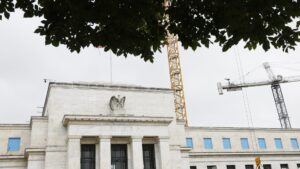The $2.5 Billion Question: Is the Federal Reserve’s Renovation Worth It?
In an era where government spending is frequently scrutinized, a recent renovation project at the Federal Reserve has ignited considerable debate. As construction wraps up around the iconic Federal Reserve building in Washington, D.C., questions arise over its staggering $2.5 billion price tag.
Elon Musk’s Challenge to Government Spending
Elon Musk, the enigmatic CEO of Tesla and the head of the newly-formed Department of Government Efficiency advisory board, has taken a sharp stance against what he perceives as excessive expenditure. In a rare interview, Musk expressed his skepticism about the renovation’s costs, stating, “What do you get for $2.5 billion in redecorating? Must be incredible.” This comment not only highlights his criticism of the renovation but also serves as a call to action for a broader assessment of government spending practices.
A Flawed Financial Forecast
Originally projected at $1.9 billion when it commenced in 2021, the renovation’s costs have spiraled due to several factors. Rising material costs, construction delays, design alterations, and site challenges have all played a role. While the Federal Reserve aims to tackle a backlog of necessary upgrades, meet evolving building codes, and enhance energy efficiency, the spike in costs raises valid concerns for taxpayers and policymakers alike.
The Value Proposition of Renovation
But what are the broader implications of this project? According to Fed officials, these renovations will not only modernize the workspace but are also intended to save money long-term by consolidating staff into a single location, thereby reducing leasing costs. Such efficiencies can lead to a more productive environment where Federal employees can effectively serve American citizens.
Musk’s Stance on Wasteful Spending
Musk argued that scrutinizing the Fed’s renovation expenses is part of a larger conversation about fiscal responsibility. His advisory board claims to have identified $160 billion in potential savings by investigating government inefficiencies. While the Fed’s renovation is a notable focal point, Musk insists that it exemplifies a systemic issue within government budget management.
The Misconception of Taxpayer Funding
It’s essential to clarify a common misconception: the Federal Reserve does not operate on taxpayer dollars. Instead, it is funded through the interest earned on its securities and fees from banks under its supervision. While normal operating profit is returned to the U.S. Treasury, the past few years have seen the Fed face operational losses due to rising interest rate payments on its reserves—an unusual but critical scenario in understanding its budget complexities.
The Road Ahead
Documents submitted to the National Capital Planning Commission detail that although the Federal Reserve building has undergone numerous renovations during its 80-year existence, many systems are now outdated, and the space doesn’t fulfill the board’s current needs.
While Musk and other critics call for stringent oversight and transparency, proponents of the renovation argue that fostering an efficient and modern workspace for one of America’s critical financial institutions is a necessary investment in the future.
At Extreme Investor Network, we believe in democratizing financial insight. Navigating through government spending can be convoluted, but staying informed empowers you to make better financial decisions.
Final Thoughts
The debate surrounding the Federal Reserve’s renovation is more than just about numbers; it’s a microcosm of the larger conversation on government accountability and fiscal prudence. In a world where every dollar counts, understanding where and how our government spends is crucial—now, more than ever.
Make sure to stay updated with Extreme Investor Network for deeper dives into government spending and finance that empower you as an informed investor.

